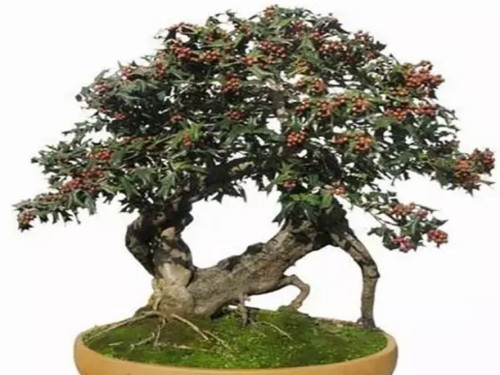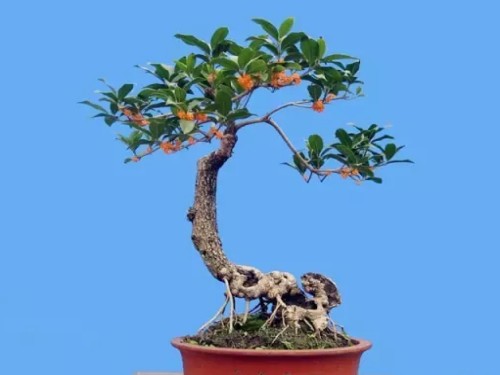Production Technology of Fujian Tea Bonsai
Fujian tea, also known as base tree and cat tree, is an evergreen shrub of Arnebiaceae. The leaves are small, long oval, dark green and shiny. White florets bloom in spring and summer, drupe globose, red after green. With its rugged trunk, colorful Qiu qu and elegant tree posture, it is one of the four major bonsai tree species in Lingnan, and it is also one of the five bonsai plants exported to the United States after China's entry into WTO (namely, boxwood, Fujian tea, Luo Han pine, sparrow plum, June snow).
Fujian tea bonsai has small white flowers in spring and summer, drupe globose and red after green. With its rugged trunk, colorful Qiu qu and elegant tree posture, it is not only one of the four major bonsai tree species in Lingnan, but also five species (that is, yellow) exported to the United States after China's entry into WTO.

I. material selection and cultivation measures
1. Artificial propagation: cuttage is usually used to propagate. In spring or plum rain season, strong annual branches or semi-mature branches of the same year were selected as cuttings, cut into 8-12 cm long, the section should be flat, leaving only a few upper leaves, the rest were cut off, and deep 1B2 was inserted. The seedbed soil had better be loose and fertile acid sandy loam, pressed after insertion, watered through, and sheltered. It is necessary to strengthen management in summer and autumn, often watering, loosening soil and weeding, and the general survival rate is still high. In the south of our country, rough cuttings or root cuttings are often used, and the survival is better.
2. Mountain mining: Fujian tea is scattered in the evergreen broad-leaved forest or shrub in the low mountains and hills of the south, and wild tree stumps or young trees can be selected. After digging back, it will be cultivated in the deep, fertile and loose soil layer in the shade, or in the sandy soil rich in organic matter, and then processed in the basin when the root system develops and the new branches and leaves are luxuriant. Lingnan Fujian tea bonsai mostly uses old tree stumps, which are made into big tree type or jungle type bonsai after "storing branches and cutting off dry method".
Second, the process of potting.
The pot is the most suitable for transplanting in early summer. Choose glazed pottery basin or purple sand pottery basin. The basin shape is more common in the medium-deep rectangle or oval shape, the cliff shape is the circular or square high-depth thousand-cylinder basin, and the jungle style is the shallow rectangular basin. The basin soil should be made of loose, fertile and well-drained slightly acidic sandy loam or mixed with pastoral soil plus farm manure and river sand. Select tiles or stones to cover the drainage hole at the bottom of the basin, and then put in a layer of river sand or vermiculite to facilitate ventilation and drainage, and then fill it into the basin soil for planting. When planting, the root system should be extended, and the main root should be slightly exposed to the soil surface. The stumps that have just come into the pot should be kept in the shade for about 15 days, and then moved to semi-shaded and well-ventilated.
Selected basin: Fujian tea can use glazed pottery basin or purple sand pottery basin. The basin shape generally uses a medium-deep rectangular or oval basin, the cliff type uses a deep round basin or a higher square thousand-cylinder basin, and the jungle type uses a shallow rectangular basin.
Use soil: Fujian tea likes fertilizer and acid, potted in the south, mostly use pond mud rich in humus, weathered and dried, loose and fertile, and then mixed with appropriate amount of river sandy soil to increase water permeability; rotten leaf soil can also be mixed with rice chaff ash.
Planting: Fujian tea is generally planted in early summer and cannot be carried out in the cold season. When planting, the roots should be stretched, obstructed with fertile soil, and the main root can be slightly exposed to the basin surface. The basin bottom had better be padded with river sand or vermiculite to facilitate ventilation and drainage.
Pruning: pruning is generally carried out in May in spring and September in autumn to remove the extra branches that affect the appearance. For the branches that need to be retained and grow too long, they can be pruned according to the method of "storing branches and cutting off stems" to maintain a certain tree shape.
Turn the basin: turn the basin and change the soil once every 2 to 3 years, at the end of spring, remove 1 to 2 old soil, cut off withered roots, rotten roots and cut too long roots, cultivate and plant with newly cultivated soil to promote the development and growth of new roots.
Third, orthopedic techniques
To make Fujian tea bonsai, one-year-old branches or semi-lignified branches with strong growth can be selected for cutting propagation in spring or plum rain season, and seedlings can also be obtained by root propagation from early summer to early autumn. in the south, wild stumps or young trees can also be dug in the woods and processed to pot after raising blanks to survive. Fujian tea is very strong in growth and resistant to pruning, so it is suitable to use the method of "storing branches and cutting dry" adopted by Lingnan bonsai to achieve the effect of natural twists and turns and vigorous branches by pruning and processing for many times.
1. Processing: Fujian tea has strong growth and is very resistant to pruning, so it is most suitable for modeling with the method of "storing branches and cutting off dry". The specific method can be referred to the section of Jiuli incense processing. If the bonsai is cultivated in the north, climbing modeling can also be carried out appropriately.
2. Tree shape: Fujian tea is suitable to be made into a natural big tree shape, which is one of the commonly used tree species of Lingnan bonsai in China. The common forms are direct dry type, double dry type, multi-dry type, oblique dry type, cliff type, jungle type and stone-attached type and so on. For the stone-attached method, please refer to the section on shaping the posture of the elm.
Time: 2019-05-26 Click:
- Prev

The method of making bonsai with Chinese wolfberry
The branches of Chinese wolfberry are dense, the leaves are peculiar, and the red fruits are bright in autumn. it is an excellent tree species for viewing leaves and fruits. Old pile bonsai posture is quaint, evergreen all the year round, suitable for viewing all the year round. Decorative applications can be cultivated as hedges in the courtyard, or potted, displayed in the hall and placed on several shelves, so as not to be touched by children because of thorns, so as to avoid injury.
- Next

How to make osmanthus bonsai
Osmanthus fragrans has luxuriant foliage, evergreen, intertwined roots, beautiful posture, gorgeous flowers and fruits, fragrant flowers, strong germination, pruning resistance, long life and other biological characteristics. It is a good tree species for processing and making bonsai trees. The production process of osmanthus bonsai is complicated, natural and wonderful.
Related
- Fuxing push coffee new agricultural production and marketing class: lack of small-scale processing plants
- Jujube rice field leisure farm deep ploughing Yilan for five years to create a space for organic food and play
- Nongyu Farm-A trial of organic papaya for brave women with advanced technology
- Four points for attention in the prevention and control of diseases and insect pests of edible fungi
- How to add nutrient solution to Edible Fungi
- Is there any good way to control edible fungus mites?
- Open Inoculation Technology of Edible Fungi
- Is there any clever way to use fertilizer for edible fungus in winter?
- What agents are used to kill the pathogens of edible fungi in the mushroom shed?
- Rapid drying of Edible Fungi

